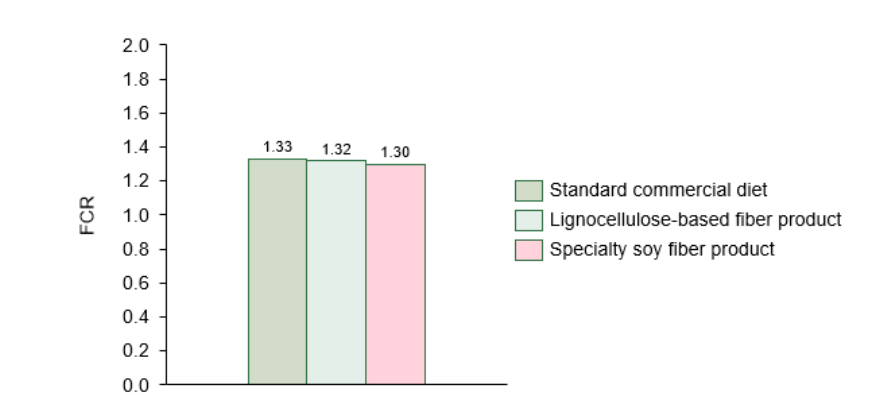



Are you choosing the right fiber source?
Using the right fiber source supports resilience of pigs and allows for simple formulation of nursery dietsWeaning is a stressful time in the life of the intensively reared pig and is associated with reduced growth performance. Part of the challenge is the abrupt change in diet from liquid, highly digestible sow milk to solid nursery feed that contains vegetable ingredients. To ease the transition, nursery diets contain highly digestible feed ingredients, but also feed additives to compensate for potential irregularities in raw materials and ingredients, which may cause digestive upset in the piglet. Consequently, nursery diets are often very complex and expensive representing an opportunity to reduce total feed costs and ease the transition from nursery diets to grower diets.
Formulating simpler diets leaving out some of the most expensive diet components reduces the feed cost, but is it feasible from a growth performance perspective? Research has shown that feeding simple versus complex nursery diets results in similar growth performance and feed efficiency from weaning to finishing as well as similar carcass characteristics (Wolter et al., 2003; Skinner et al., 2014). Thus, simpler diets can be fed during the nursery without compromising long term animal productivity. Question now is how to formulate simple (clean) nursery diets while maintaining high performance.
To succeed, aspects like good gut health and improved resilience of the pigs, are more important than ever to consider when formulating nursery diets. With the ban on pharmacological levels of zinc in the European Union and the increasing concerns about the use of antibiotic growth promoters (AGP) globally, few aids for ensuring piglet performance are left. Maintaining good gut health is crucial as the gut is the main barrier against pathogens and potentially harmful substances. By ensuring good gut health in nursery pigs, the upper threshold for what piglets can handle in terms of stressors just after weaning (change in environment, feed changes and pathogenic pressure) may be elevated, adding to the resilience of the piglet. One way of supporting resilience in nursery pigs is by the addition of fiber to the diet.
Fiber as functional ingredient
Fiber has previously been regarded as an anti-nutrient in monogastric nutrition since it is not digested by endogenous enzymes and has been found to reduce nutrient digestibility at high contents in the diets (Kornegay et al., 1995; Berrocoso et al., 2015). However, the concept of using fiber as a functional ingredient, which induces physical and physiological benefits in the host, in nursery diets has gained traction due to the positive effects on gut health (Jha et al., 2019).
The benefits of fiber depend on the physicochemical characteristics of the fiber. Dietary fiber consists of various fractions and are typically defined as being soluble or insoluble (Montagne et al., 2003). Soluble fiber is resistant to digestion by endogenous enzymes but acts as substrate for microbiota that through fermentation produce organic acids (e.g. butyrate) and other metabolites in the hindgut. These metabolites contribute to gut health by serving as energy source for epithelial cells, improving the gut barrier function and having anti-inflammatory properties (Knudsen et al., 2018; Jha et al., 2019). Insoluble fiber on the other hand mainly exert physical effects by stimulating peristaltic movements and reducing the adhesion of potential pathogen bacteria to the gut wall (Molist et al., 2014).
The right combination of fibers adds to the resilience of piglets
A trial recently presented at Zero Zinc Summit 2022 (Rasmussen et al., 2022) showed the effect of clean nursery diets supplemented with two different fiber sources (specialty soy fiber product or lignocellulose-based fiber product) on performance of nursery pigs compared to a standard commercial diet containing various gut health promoting feed additives but with no additional fiber.
Results showed that it is possible to formulate and feed clean nursery diets while maintaining piglet performance by the addition of fiber to the diet (figure 1). At the same conference Prof. Dr. Jürgen Zentek, Institut für Tierernährung, Freie Universität Berlin showed that a specialty soy fiber product can be included up to 6% in the nursery diets without detrimental effects on performance (Saliu et al., 2022). Interestingly, results from Rasmussen et al. (2022) also showed that the fiber type matters in the resilience of pigs. The specialty soy fiber product reduced the number of pigs lost (mortality+morbidity) compared to the lignocellulose-based fiber product and the standard commercial diet (figure 2). Thus, fewer piglets needed medical treatment indicating that the specialty soy fiber product improved the resilience of piglets. Despite similar performance and diet costs, the margin per pig sold was higher for the specialty soy fiber group due to fewer pigs lost compared to the standard commercial diet and lignocellulose-based fiber group.


The combination of soluble and insoluble fiber in the specialty soy fiber product as well as its prebiotic properties has likely contributed to maintain a healthy gut microbiota through an increased production of fermentation metabolites (e.g. short chain fatty acids; SCFA) thereby improving resilience of piglets. Thirup et al. (2021) found increased butyrate concentration and decreased protein fermentation in colon in-vitro with the addition of the specialty soy fiber product compared to no added fiber and a lignocellulose-based fiber product. The lignocellulose-based fiber product, a source of insoluble fiber, did not have the same effect on piglet resilience as the specialty soy fiber product. Thus, it is not only the addition of fiber, but the type of fiber – or the combination of different fiber fractions – that is of importance when formulating clean nursery diets. Piglets may need both soluble and insoluble fiber and by feeding both, pigs may become more resilient.
The use of the right fiber source in nursery diets comes with several benefits. It improves resilience of pigs which may reduce the need for medical interventions and makes the formulation of nursery diets with a slightly reduced crude protein content possible whilst performance is maintained and the risk of post-weaning diarrhea is reduced. In addition, the use of the right fiber source allows for the formulation of simple nursery diets in the post ZnO era by reducing the dependency on feed additives, thus providing a cost-effective alternative to otherwise complex standard nursery diets.
| References | ||||
|---|---|---|---|---|
| Berrocoso, J. D.; Menoyo, D.; Guzmán, P.; Saldaña, B.; Cámara, L.; Mateos, G. G., | ||||
| (2015) | Effects of fiber inclusion on growth performance and nutrient digestibility of piglets reared under optimal or poor hygienic conditions.. Journal of Animal Science | 93, 3919–3931. | ||
| Jha, R.; Fouhse, J. M.; Tiwari, U. P.; Li, L.; Willing, B. P., | ||||
| (2019) | Dietary fiber and intestinal health ofmonogastric animals.. Frontiers in Veterinary Science., | 6, 1–12. | ||
| Knudsen, K. E. B.; Lærke, H. N.; Hedemann, M. S.; Nielsen, T. S.; Ingerslev, A. K.; Nielsen, D. S. G.; Theil, P. K.; Purup, S.; Hald, S.; Schioldan, A. G.; Marco, M. L.; Gregersen, S.; Hermansen, K., | ||||
| (2018) | Impact of diet-modulated butyrate production on intestinal barrier function and inflammation.. Nutrients. | 10. | ||
| Kornegay, E. T.; Rhein-Welker, D.; Lindemann, M. D.; Wood, C. M., | ||||
| (1995) | Performance and nutrient digestibility in weanling pigs as influenced by yeast culture additions to starter diets containing dried whey or one of two fiber sources.. Journal of animal science., | 73, 1381–1389. | ||
| Molist, F.; van Oostrum, M.; Pérez, J. F.; Mateos, G. G.; Nyachoti, C. M.; van der Aar, P. J. | ||||
| (2014) | Relevance of functional properties of dietary fibre in diets for weanling pigs.. Animal Feed Science and Technology., | 189, 1–10. | ||
| Montagne, L.; Pluske, J. R.; Hampson, D. J., | ||||
| (2003) | A review of interactions between dietary fibre and the intestinal mucosa, and their consequences on digestive health in young non-ruminant animals.. Animal Feed Science and Technology., | 108, 95–117. | ||
| Rasmussen, S. H.; van Leeuwen, J.; Dubberke, G., | ||||
| (2022) | Effect of two sources of dietary fiber on health and performance of weanling pigs.. Zero Zinc Summit. Copenhagen. | |||
| Saliu, E. M.; Rasmussen, S. H.; van Leeuwen, J.; Zentek, J., | ||||
| (2022) | The impact of adding different levels of enzyme-treated soy fibre to weaners diets on performance and short chain fatty acid production in the hindgut.. Animal - Science Proceedings, | p. 200. | 15th International Symposium on Digestive Physiology of Pigs. | |
| Skinner, L. D.; Levesque, C. L.; Wey, D.; Rudar, M.; Zhu, J.; Hooda, S.; de Lange, C. F. M., | ||||
| (2014) | Impact of nursery feeding program on subsequent growth performance, carcass quality, meat quality, and physical and chemical body composition of growing-finishing pigs.. Journal of Animal Science., | 92, 1044–1054. | ||
| Thirup, L.; Rasmussen, S. H.; Apajalahti, J.; Rinttila, T.; Brøkner, C., | ||||
| (2021) | Ex-vivo gas- and organic acid production when incubating fiber products with colon inoculum from weaned piglets.. 75. Tagung der Gesellschaft für Ernährungsphysiologie (GfE)., p. Abstract 115. | |||
| Wolter, B. F.; Ellis, M.; Corrigan, B. P.; DeDecker, J. M.; Curtis, S. E.; Parr, E. N.; Webel, D. M., | ||||
| (2003) | Impact of early postweaning growth rate as affected by diet complexity and space allocation on subsequent growth performance of pigs in a wean-to-finish production system.. Journal of Animal Science., | 81, 353–359. |



